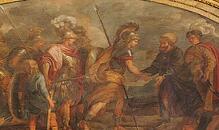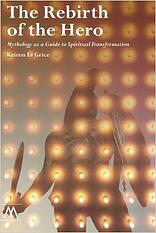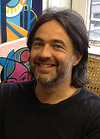A guest post by Dr. Keiron Le Grice
 Modern-day cinematic portrayals of myths old and new are etched in our collective imagination. Who can forget the 1960s film depiction of the Greek hero Jason and the crew of the Argo boldly sailing their ship between the Clashing Rocks or Luke Skywalker unmasking his father, Darth Vader, in Star Wars? And how many of us were enthralled watching Frodo Baggins accepting his fateful mission to carry the Ring of Power away from the Shire or were enchanted by the other-worldly experiences of Dorothy in The Wizard of Oz? Such films comprise a set of shared cultural reference points and have inspired audiences the world over. Yet beyond their capacity to entertain and stir the imagination, mythic films also possess an instructive metaphorical significance. Skilfully interpreted, they can provide invaluable guidance for the process of deep psychospiritual transformation that Carl Jung called individuation. It is this way of reading and using myth that is the focus of my 2013 publication, The Rebirth of the Hero.
Modern-day cinematic portrayals of myths old and new are etched in our collective imagination. Who can forget the 1960s film depiction of the Greek hero Jason and the crew of the Argo boldly sailing their ship between the Clashing Rocks or Luke Skywalker unmasking his father, Darth Vader, in Star Wars? And how many of us were enthralled watching Frodo Baggins accepting his fateful mission to carry the Ring of Power away from the Shire or were enchanted by the other-worldly experiences of Dorothy in The Wizard of Oz? Such films comprise a set of shared cultural reference points and have inspired audiences the world over. Yet beyond their capacity to entertain and stir the imagination, mythic films also possess an instructive metaphorical significance. Skilfully interpreted, they can provide invaluable guidance for the process of deep psychospiritual transformation that Carl Jung called individuation. It is this way of reading and using myth that is the focus of my 2013 publication, The Rebirth of the Hero.
The modern revival of interest in myth owes much to the work of Joseph Campbell. His best-known and highly influential The Hero with a Thousand Faces (1949) became something of a guidebook for inner self-exploration in the 1960s counterculture. More recently, Campbell’s Power of Myth interviews with Bill Moyers, broadcast in the late 1980s, introduced a wide audience to the idea that myth, despite its ancient origins, can provide much needed orientation and life meaning for the modern individual.
 In 2010, teaching at the California Institute of Integral Studies in San Francisco, I had the opportunity to design a graduate course on Campbell’s work, and it was out of the material for that course that The Rebirth of the Hero emerged. In creating the syllabus I was particularly interested in two main areas: First, how an individual’s transformative experiences are related to the larger context of the evolution of Western civilization, from ancient Greek thought and Judeo-Christianity to the modern era; and, second, how Campbell’s description of the mythic pattern of the hero’s journey—the monomyth, as he termed it—can be applied to help the individual navigate experiences of psychological transformation. These topics are addressed in turn in the two parts of my book.
In 2010, teaching at the California Institute of Integral Studies in San Francisco, I had the opportunity to design a graduate course on Campbell’s work, and it was out of the material for that course that The Rebirth of the Hero emerged. In creating the syllabus I was particularly interested in two main areas: First, how an individual’s transformative experiences are related to the larger context of the evolution of Western civilization, from ancient Greek thought and Judeo-Christianity to the modern era; and, second, how Campbell’s description of the mythic pattern of the hero’s journey—the monomyth, as he termed it—can be applied to help the individual navigate experiences of psychological transformation. These topics are addressed in turn in the two parts of my book.
It struck me, both from my own experience and from testimonies of other people, that typically, when a person goes through an existential crisis or an episode of deep psychological transformation, this experience is often viewed in isolation, seen as an entirely personal crisis, with no appreciation of the wider context. The nature of these experiences is such that one can find oneself in a state of utter confusion, perhaps even trauma, and lacking a theoretical framework that could help to make sense of what one is going through. My aim in Part One of the book, therefore, was to try to present a “big picture” view that could help people understand how their own psychological transformations and individuation journeys are related to our collective history, and particularly to the relationship between spirit and nature in the West. To do this, I examine factors such as the implications of the biblical Fall of Man, the psychological consequences of the ethical separation of good from evil in Christianity, the tension between reason and instinct, the patriarchal structure of Western civilization, the repression of the feminine, the rise of the mechanistic-materialistic worldview, the decline of Christianity as the dominant cultural myth (heralded by Friedrich Nietzsche’s proclamation of the “death of god”), and the emphasis on the individual in the Western spiritual tradition. All these factors and more have been prominent in shaping our understanding of life in the modern West and giving rise to the experience of ourselves as autonomous individual egos, existentially separate from, and perhaps alienated from, the world around us and even from our own deeper being. In response, however, these same conditions also call forth a profound inner transformation that might lead us beyond the limitations of the ego, beyond the normal human condition, towards greater psychological wholeness and integration. Needless to say, this transition is arduous, fraught with difficulty and danger. With good reason, Jung described individuation as a Herculean labour.
One function of myth is to provide symbolic guidance to help us navigate this process. Indeed, Campbell’s model of the hero’s journey can be seen as a symbolic portrayal of individuation. With this in mind, Part Two of my book draws on examples from mythic films, spiritual texts, and the biographies of Jung, Campbell, and Nietzsche to explore the various stages of the hero’s journey—such as the call to adventure, the refusal of the call, the descent into the underworld, the return, and more. These examples provide illuminating illustrations of particular experiences one might go through during different stages of psychological transformation. For example, the Argo’s passage between the Clashing Rocks in Jason and the Argonauts gives a vivid idea of what it is like when the inner being is moving out of the shell of the old personality. Under intense psychological pressure the old structures of the ego personality start to crumble and one can have the feeling that consciousness is passing through the psychological opposites into a new, fuller reality on the other side. As in the film, in which the ship is granted safe passage by the sea god Triton, so in a rebirth experience one can have the sense that a greater power is there in the background aiding the transition like a kind of cosmic midwife. A similar threshold-crossing experience is also suggested in The Matrix, in which the protagonist Neo, famously swallowing the red pill, chooses to discover the truth behind the world illusion that is the Matrix and passes through a kind of death-rebirth process in which he is stripped of his former worldly identity as he emerges into a grim underground reality.
The confrontation with what I call the “empire of the ego” is one key aspect of deep psychological transformation. In mythic films, this “empire” is often symbolically suggested by evil dictators or tyrants (such as Palpatine in Star Wars or Emperor Ming in Flash Gordon or Saruman in The Lord of the Rings) who typically command vast armies of warriors to enforce control and to exert power, just as, in psychological terms, the defences of the ego can inhibit and repress other aspects of the psyche, keeping the authentic self imprisoned within. Another major motif of the individuation process is the underworld descent and the challenge of taming the beast within––the challenge, that is, of bringing the primitive instincts in the depths of the psyche under control such that one can grow free of their compulsive power. As the old psychological structures weaken and collapse during individuation, so instincts are released into consciousness. The archetypal imagination often portrays such instincts in animal form, and in myth, of course, encounters with ferocious dragons, monsters, and beasts (such as the Kraken or Medusa in Greek myth, or the Balrog in The Lord of the Rings) are prominent themes. The hero is challenged to subdue the beast not in order to repress or extinguish instinct, but to align his or her will with instinct in a positive way––to “ride the back of the Dionysian leopard,” as Campbell put it. Myths provide clues as to how this can be done.
Of critical importance throughout the hero’s journey is the feminine principle, which, in Jungian terms, takes the form of encounters with the archetypes of the Great Mother and the anima. The journey leads the rational ego, conditioned by masculine bias of Western civilization, into relationship with the long-repressed feminine that it might liberate and integrate what Jung calls the “dark spirit in nature.” In mythic terms, the hero returns to the Great Mother for renewal, for she is the source of both life and death, the matrix from which all forms emerge. And the anima––the archetype of life, and intimately associated with feeling––can serve as the guide for this adventure if one is able to resist the alluring temptations of the passions and attune to the voice of the soul within. Ultimately, individuation, as symbolized by the voyage of the hero, leads towards a union of masculine and feminine, spirit and nature, to be realized in the mystic marriage or hieros gamos. It is a journey that many of us today find ourselves undertaking.
* This article first appeared in Watkins Mind-Body-Spirit magazine, #37, spring 2014.
 Dr. Keiron Le Grice is a professor of depth psychology and chair of the Jungian and Archetypal Studies specialization at Pacifica Graduate Institute, Santa Barbara, where he teaches courses on archetypes, alchemy, synchronicity, and the history of depth psychology. Keiron is the author of three books––The Archetypal Cosmos, Discovering Eris, and The Rebirth of the Hero––and is founding editor of Archai: The Journal of Archetypal Cosmology. Keiron has also taught in the Philosophy, Cosmology, and Consciousness program at the California Institute of Integral Studies in San Francisco, and serves as commissioning editor for Muswell Hill Press in London. His website is www.keironlegrice.com.
Dr. Keiron Le Grice is a professor of depth psychology and chair of the Jungian and Archetypal Studies specialization at Pacifica Graduate Institute, Santa Barbara, where he teaches courses on archetypes, alchemy, synchronicity, and the history of depth psychology. Keiron is the author of three books––The Archetypal Cosmos, Discovering Eris, and The Rebirth of the Hero––and is founding editor of Archai: The Journal of Archetypal Cosmology. Keiron has also taught in the Philosophy, Cosmology, and Consciousness program at the California Institute of Integral Studies in San Francisco, and serves as commissioning editor for Muswell Hill Press in London. His website is www.keironlegrice.com.



